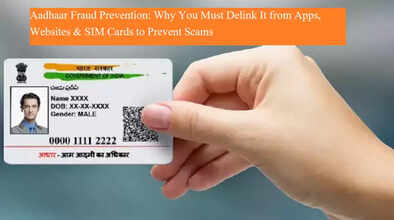Aadhaar Fraud Prevention: Why You Must Delink It from Apps, Websites & SIM Cards to Prevent Scams

Aadhaar Fraud Prevention: Delink from Unwanted Platforms Before It's Too Late
With the increasing number of Aadhaar-related scams in India, it's crucial for individuals to take control of their Aadhaar data and safeguard it from falling into the wrong hands. Most people link their Aadhaar number with various apps, websites, and mobile numbers without realizing the security risks. Cybercriminals are exploiting this widespread practice to steal personal information and commit fraud. The good news is—there’s a simple yet effective way to prevent these scams: delinking your Aadhaar from unnecessary platforms.
In this article, we’ll explore why delinking Aadhaar is essential, how it protects you from fraud, and the step-by-step process to secure your Aadhaar data from misuse.
Why Aadhaar Delinking Is So Important
Most users in India use Aadhaar for verification purposes in banking, mobile connections, and online services. While convenient, this also opens multiple avenues for fraudsters to misuse sensitive information. Fraudsters often gain access to mobile numbers, digital wallets, and apps linked to Aadhaar, enabling them to commit financial fraud without the victim even realizing it.
If your Aadhaar number is linked to platforms you no longer use or don't trust, it's time to clean house. Delinking can stop potential misuse, especially in the case of lost or inactive devices, or compromised applications.
Use Virtual ID or Masked Aadhaar Instead
One smart way to shield your Aadhaar information is by using a Virtual ID (VID) or Masked Aadhaar. A Virtual ID is a temporary, revocable 16-digit code that can be used in place of your Aadhaar number for authentication. Similarly, Masked Aadhaar displays only the last four digits of your Aadhaar number, hiding the rest.
Both options allow you to verify your identity without exposing the full Aadhaar number. Whether you're checking into a hotel, completing KYC at a bank, or signing up for an app, these alternatives add a vital layer of security.
How to Delink Aadhaar from Your Mobile SIM
Until recently, Aadhaar was mandatory for SIM card verification, but that’s no longer the case. If your mobile number is still linked with Aadhaar, you can request delinking through your telecom provider. Visit the nearest store and provide an alternative ID proof such as a PAN card or voter ID. Ask the representative to remove Aadhaar details from your records.
Once delinked, it becomes difficult for unauthorized parties to access your Aadhaar information via your SIM card.
Check Your Aadhaar Authentication History
Worried your Aadhaar might already have been misused? There’s a way to check. Visit the official UIDAI website and log in with your Aadhaar number. Under “Aadhaar Authentication History,” you can track where and how many times your Aadhaar has been used for eKYC or verification.
This feature helps identify suspicious activities. If you find Aadhaar linked to platforms you no longer use, immediately take steps to delink your details from those services.
Final Tips to Keep Aadhaar Safe
-
Avoid linking Aadhaar to every app or service—use it only when absolutely necessary.
-
Use Virtual IDs or Masked Aadhaar instead of your actual number for eKYC.
-
Regularly check your authentication history via UIDAI's website.
-
Contact your bank or telecom provider to delink Aadhaar from unused numbers or services.
In Conclusion
Your Aadhaar is a gateway to many of your personal and financial details. By taking simple precautions like delinking from old SIMs, unused apps, or untrusted websites, and using secure alternatives like VID or Masked Aadhaar, you can effectively shield yourself from scams. In an age where data is everything, a proactive approach can save you from huge losses and headaches.
Stay alert, stay safe—and take control of your digital identity today.

